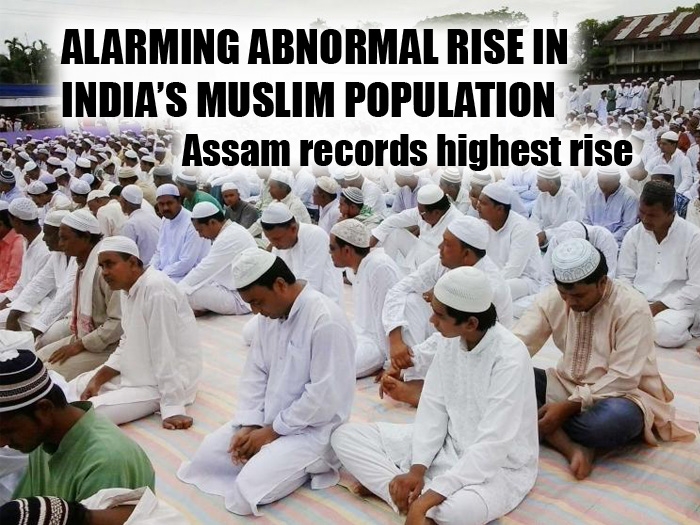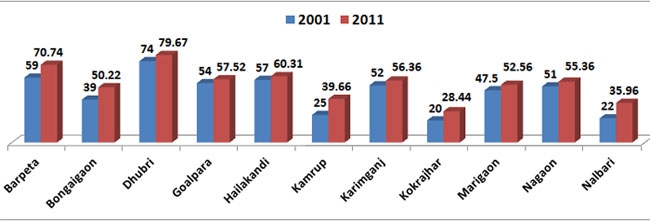Hindus grow 15% Muslims 24%: #ReligionCensus2011 data tells the tale
New Delhi, August 25: The Religion based Census data released today by the Registrar General and Census Commissioner of India showed a significant rise in proportion of Muslim population in India than its Hindu population. Compared to 2001 data, the decadal growth of population of Muslims in India is 24%. The data on “Population by Religious Communities of Census 2011” indicates that the proportion of Muslims to the total population is growing faster than that of other religions.

The #ReligionCensus2011 data gives the distribution of total population by six major religious communities namely, Hindu, Muslim, Christian, Sikh, Buddhist, Jain besides “Other Religions and Persuasions” and “Religion not stated”. The data are released by sex and residence up to districts.
Religion wise population: 2011 and 2001
Total Population in 2011 is 121.09 crores ; Hindu 96.63 crores (79.8%); Muslim 17.22 crores (14.2%); Christian 2.78 crores (2.3%); Sikh 2.08 crores (1.7%); Buddhist 0.84 crores (0.7%); Jain 0.45 crores (0.4%), Other Religions & Persuasions (ORP) 0.79 crores (0.7%) and Religion Not Stated 0.29 crores (0.2%).
In 2001, India’s total population was 1,028,610,328 827, in which Hindus were 578,868 (80.46%), Muslims were 138,188,240 (13.43%), Christians were 24,080,016 (2.34%), Sikh population was 19,215,730, Buddhists were 7,955,207, Jains were 4,225,053, other were 6,639,626 and 727,588 was the number of Religion Not Stated.
When compared to 2001 numbers, the data in 2011 shows that the Hindus population in Assam is 19180759 (61.46%) with a remarkable decline of 3.43%. The population of Muslims is 10679345 (34.22% ) which is a significant increase by 3.3% in the state of Assam adjoining the Bangladesh. The Christians in the state are 1165867 (3.73%) with a thinner rise of 0.03%.
The data on population by religious communities from Census 2011 evidences that the proportion of Muslims to the total population is growing faster than that of other religions.
Muslims growing faster, shows the data
NewsBharati will analyse this data and its causes and impacts in due course but primarily there are two states where the religion balance-imbalance matters for Indian democracy. Those two states are Assam and West Bengal. In these states the added dimension of Bangladeshi infiltration causes major political as well as security implications to the changing demographic scenario.
West Bengal
The West Bengal 2001 Religion census data showed the total population of 80176197. In 2011, this number increased to 91276115 with a rise of 11099918.
The Hindu population of West Bengal in 2001 was 58104835 (72.47), Muslim population was 20240543 (25.25%) and Christians were 515150 (0.64%).
The 2011 data show that the total population of West Bengal has increased to 91276115. The actual rise in population increased is 11099918. The Hindu population in WB is 64385546 (70.53%) with a visible noteworthy decline of 1.94%. The Muslim population in the state is 24654825 (27.01) which has increased noticeably by 1.76%, which is almost double of Muslim national growth. And the Christian population is 658618 (0.72%) with a modest rise of 0.08%.
Assam
Total population of Assam in 2001 was 26655528. In 2011, it jumped to 31205576 with an astonishing number of 4550048. This is showing almost five times considerable rise as compared to the national average of 0.8%. As per 2001 Census data, the Hindu population in Assam was 17296455 (64.89%), Muslim population was 8240611 (30.92%) and Christian population was 986589 (3.7%) of the total 26655528 population of the state.
Assam stats show staggering disproportion
Most significant is the population disproportion in Assam. NewsBharati team did a quick recheck of the district wise growth of Muslim population and found the numbers which tell the tale of alarming rise of Muslims in the districts bordering to the Islamic Bangladesh.
Dhubri, the bordering district is Assam marks a shocking rise to 79.67% from 74% in its Muslim population. Dhubri is infamous for continuous riots between Bodos and Bengali speaking Muslims considered as infiltraters from Bangladesh. Another border district Barpeta shows 70.73% Muslims now, a staggering rise of about 20% since 2001. Similarly the shocking rise of Muslims in districts of Assam like Darang (64.33%), Hailakandi (60.31%), Goalpara (57.52), Karimganj (56.36%), Nagaon (55.35%), Marigaon (52.56%), Bongaigaon (50.22%), Kamrup (39.65%), Cachar (37.7%), Nalbari (35.96%) and riot prone Kokrajhar (28.43%) is showing an alarming signal for Indian demography and democracy.
The roots and causes of the abnormal growth of muslims in India might be numerous but the increase of Muslim population which has a minority status in India cannot be undermined when it comes to basic human rights of Indians including Muslim citizen of India and also to the national security particularly when the infiltration from Bangladesh has become a haunting issue.


